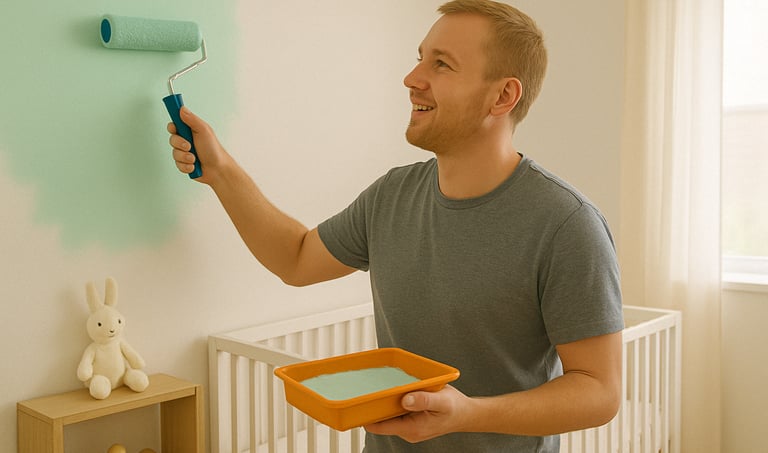How to Prepare Your Baby’s Room (Without Losing Your Mind)
To welcome your baby into a healthy and soothing space, it’s best to get the nursery ready at least three months before the due date — this gives plenty of time to air out the room after any painting or setup. When it comes to paint, choose a low-VOC acrylic option, and consider painting just one wall in a soft, calming color like sage green or light terracotta for a simple, stylish, and flexible look. Keep the decor minimal, gender-neutral, and easy to adapt as your child grows. Go for items that are easy to move or update — like wall decals, prints, or floating shelves — and always prioritize practicality. Avoid over-the-top trends and focus instead on creating a space that feels warm, functional, and built to last.
DIY PROJECTS
5/8/20243 min read


Getting the nursery ready is often an emotional milestone during pregnancy. But it’s also a real project that shouldn’t be underestimated. Between painting, choosing colors, decorating, and imagining how the space will evolve, there are many decisions to make.
In this article, I’m sharing a clear, experience-based method for preparing a baby’s room — with a focus on painting and wall decor. The goal: keeping it simple, functional, and long-lasting.
🕒 Why You Should Finish the Nursery Three Months Before Baby Arrives
It’s not just a nice-to-have. Ideally, the nursery should be ready at least three months before the due date, for several important reasons:
To ventilate the room naturally after painting, assembling furniture, or installing flooring
To remove any lingering odors or harmful substances in paints or adhesives
To give yourself time to fine-tune the layout, add finishing touches, or deal with surprises
To avoid last-minute stress — especially if baby comes early
Starting early gives you the luxury of doing things calmly and thoughtfully, rather than rushing decisions at the last minute.
🎨 What Kind of Paint Should You Use in a Baby’s Room?
1. Choose Paint That’s Safe for Newborns
A baby’s skin and respiratory system are extremely sensitive.
It’s essential to choose water-based paint (acrylic) that is low-VOC or VOC-free (look for “A+” labels or the European Ecolabel). These formulas are designed to reduce toxicity in indoor spaces.
Avoid at all costs: solvent-based paints, strong varnishes, or anything with a strong chemical odor.
2. Go for Soft, Timeless Colors
The goal isn’t to create a magazine-worthy room, but a peaceful, soothing space that promotes rest and comfort. Choose light, natural tones that are calming and easy to match:
Sage green
Soft terracotta
Dusty blue or blue-grey
Natural beige or ivory
Linen white or off-white
These colors blend easily with other decor elements and age well over time.
3. Paint Just One Wall — a Smart & Stylish Trick
If painting the entire room feels overwhelming, consider painting just one wall — the one behind the crib or at the back of the room. This creates a cozy accent wall without visual overload.
It’s faster, cheaper, and easier to update later. Plus, it gives you a decorative feature without committing to a full-room color.
🌱 How to Create a Nursery That Grows With Your Child
1. Think Ahead: Plan for the Room to Evolve
Newborns quickly become toddlers — and then kids with their own personalities.
That’s why it’s smart to avoid baby-themed decor that won’t last:
Skip permanent wall borders or overly cute murals
Choose moveable decor: framed prints, garlands, removable stickers
Use neutral storage that can still be useful in 5 years
And think long term — this room might later become an office, a guest room, or a playroom. Design for flexibility.
2. Avoid Gendered Decor
People still often default to pink for girls and blue for boys. But super-gendered themes can limit how the room evolves over time.
Instead, choose neutral, nature-inspired, or soft color palettes that work for any child and can grow with their interests.
Some timeless, unisex themes to consider:
Nature (forests, animals, mountains)
Sky (clouds, stars, moon)
Vintage (light wood, rattan, cozy textures)
3. Choose Practical Over “Pinterest Cute”
Sure, unicorn lamps and bunny chairs are adorable. But comfort, safety, and easy cleaning matter more.
Here are some practical decor ideas that still look great:
Open wall shelves for books and small items
A soft toy basket you can move around easily
A washable rug (great for quick diaper changes on the floor)
A dimmable lamp for night feedings or quiet wake-ups
🌀 Should You Follow Nursery Trends?
Instagram and Pinterest are full of beautiful baby rooms — and while inspiring, they can also set unrealistic expectations.
A nursery doesn’t have to be “perfect” to be beautiful and welcoming. Above all, it should:
Be safe and healthy for your baby
Be easy to live in (especially during those sleep-deprived nights)
Adapt easily as your child grows
If you fall in love with a trend, ask yourself:
“Will I still love this in two years?”
“Is it easy to clean and maintain?”
“Is it actually useful?”
📝 In Short: Key Points for a Calm, Thoughtful Nursery
Start preparing 3 months before the due date
Use low-VOC water-based paints
Consider painting just one wall for simplicity and style
Stick with soft, neutral colors
Choose non-gendered, adaptable decor
Prioritize function over looks
Don’t let trends dictate what matters to you
Designing a nursery isn’t just about decorating a room — it’s about creating a space for life, rest, and growth.
If you take the time to carefully choose the paint, colors, and decor, you’re laying the foundation for a calm and comforting space — one that supports your child’s first months and your everyday joy as a parent.
